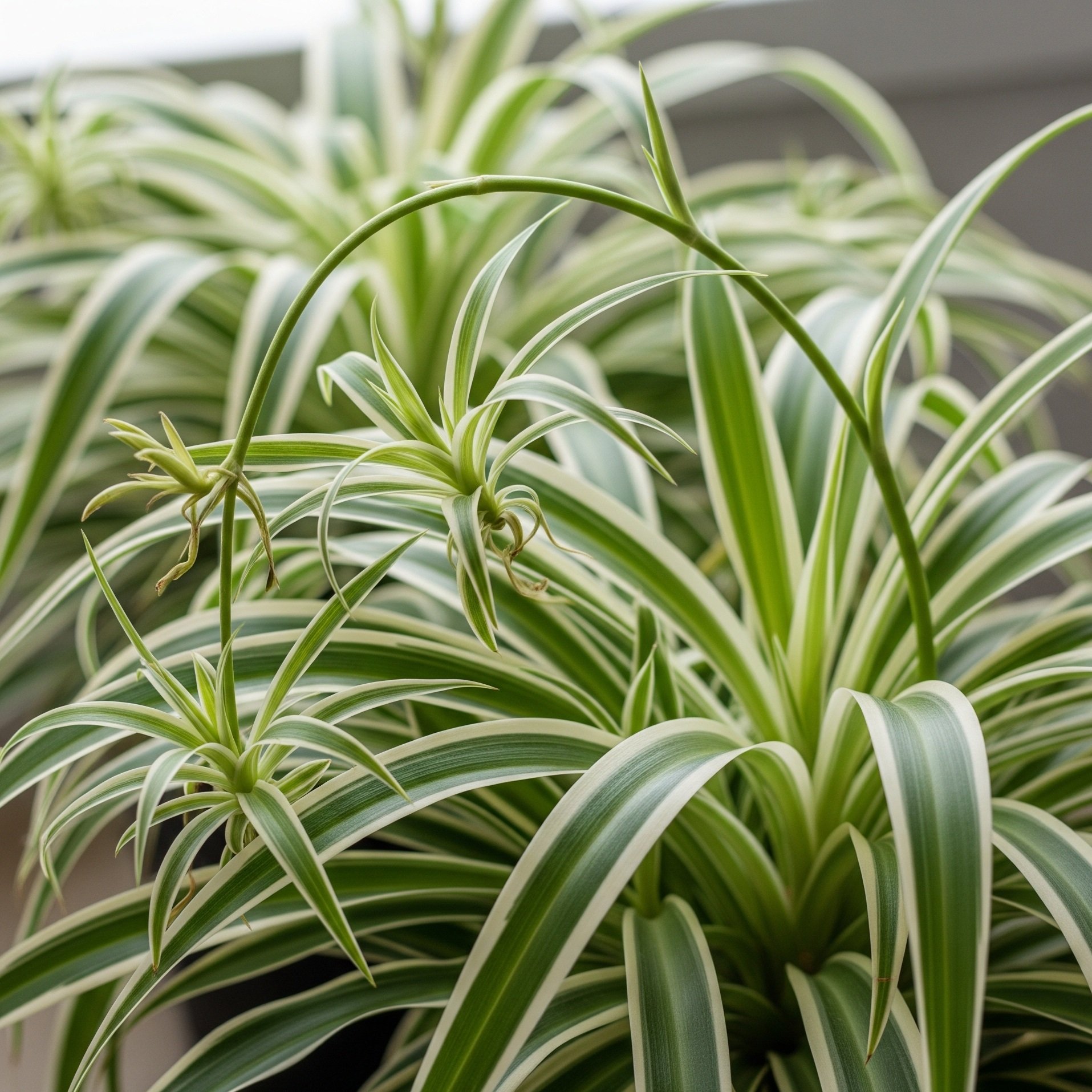 Image 1 of 1
Image 1 of 1


Chlorophytum comosum 'Reverse Variegatum'
Chlorophytum comosum 'Reverse Variegatum'
The Reverse Variegated Spider Plant
Your quest for effortless greenery ends here with the charming Chlorophytum comosum 'Reverse Variegatum', commonly known as the Reverse Variegated Spider Plant or Airplane Plant. This beloved classic offers a refreshing twist, showcasing stunning bright white or cream margins bordering a vibrant green center. It's an instant bright spot, adding a cheerful, natural touch to any setting.
A Twist on a Timeless Favorite
Unlike its more common siblings, the 'Reverse Variegatum' proudly displays its dramatic white or creamy outer edges, elegantly framing a central stripe of rich green. This inverted pattern creates a striking visual contrast, ensuring it stands out whether cascading from a hanging basket or brightening a desktop. Its elegant form and gracefully arching foliage make it a delightful focal point.
Effortless Elegance & Abundant Growth
Renowned for its unparalleled ease of care, the Reverse Variegated Spider Plant is a dream come true for both beginners and seasoned enthusiasts. It's incredibly forgiving, adapting beautifully to a wide range of indoor conditions. Watch in delight as it readily produces "plantlets" or "spiderettes" on long arching stems, offering an endless supply of new plants to share or expand your own collection. This prolific nature makes it a joyous addition to any home or office.
The TC Advantage
Our tissue culture (TC) propagation ensures you receive a robust, pest-free plant with multiple growth points already established. This means faster, fuller growth from day one, so you can enjoy its characteristic plantlet production and cascading beauty sooner.
Care & Growth
Light: Position your spider plant in bright, indirect light to showcase its beautiful variegation, though it will tolerate lower light conditions if needed.
Watering: Allow the top inch or two of soil to dry out completely between waterings, as spider plants prefer to dry slightly between drinks. You'll know it's time to water when the green color near the base of the plant starts to fade. If you wait too long, the leaf tips will turn brown as a gentle reminder.
Root Health: Spider plants actually prefer to be slightly rootbound before they begin producing their charming offshoots, so don't rush to repot.
Humidity: These adaptable plants thrive in average household humidity levels, making them perfect for most homes.
Maintenance: Simply trim older or damaged leaves as needed to keep your plant looking tidy and healthy.
Pro Tip #1
After watering your plant, pick it up and remember how heavy it feels when fully saturated. This weight will become your reference point – when you lift the plant in the future and it feels noticeably lighter, you'll know it's time to water again. This simple technique works for most houseplants and takes the guesswork out of watering schedules!
Propagation:
This classic houseplant is incredibly easy to propagate, making it perfect for sharing with friends or expanding your collection. Spider plants produce small plantlets (called "spiderettes" or "pups") on long, arching stems that dangle from the mother plant. Simply place a small pot of soil beneath one of these baby plants while it's still attached to the parent, allowing the roots to develop in the new pot. Once the roots are established (usually within a few weeks), you can cut the connecting stem and you'll have a brand new spider plant ready to thrive on its own.
Pro Tip #2: Cultivating a Show-Stopping Spider Plant
If you're aiming for a truly magnificent, large specimen spider plant that creates a cascading waterfall effect of offshoots and delicate small white flowers, you have a few great options once your mature plant starts producing "spiderettes." You can root these plantlets in water for individual new plants, or for a denser display, plant the mother in the center of a large hanging basket and then plant the unsevered plantlets directly into the surrounding soil – this method allows the mother to continuously supply nutrients for faster establishment. Alternatively, you can take all your already rooted plantlets and add them to a large pot with the mother plant, or even create a stunning, full basket composed entirely of rooted plantlets, offering flexibility to achieve your impressive spider plant vision.
Pet Safety
Good news! Spider plants (Chlorophytum comosum) are generally considered non-toxic to both cats and dogs by organizations like the ASPCA.
However, Mild Gastrointestinal Upset: While not toxic, if pets ingest large quantities of the plant material, it can still cause mild gastrointestinal upset, such as vomiting or diarrhea.
So, while they are safe for pets, it's still a good idea to monitor your pet's interaction with the plant, especially if they show a strong interest in nibbling on it.
Chlorophytum comosum 'Reverse Variegatum'
The Reverse Variegated Spider Plant
Your quest for effortless greenery ends here with the charming Chlorophytum comosum 'Reverse Variegatum', commonly known as the Reverse Variegated Spider Plant or Airplane Plant. This beloved classic offers a refreshing twist, showcasing stunning bright white or cream margins bordering a vibrant green center. It's an instant bright spot, adding a cheerful, natural touch to any setting.
A Twist on a Timeless Favorite
Unlike its more common siblings, the 'Reverse Variegatum' proudly displays its dramatic white or creamy outer edges, elegantly framing a central stripe of rich green. This inverted pattern creates a striking visual contrast, ensuring it stands out whether cascading from a hanging basket or brightening a desktop. Its elegant form and gracefully arching foliage make it a delightful focal point.
Effortless Elegance & Abundant Growth
Renowned for its unparalleled ease of care, the Reverse Variegated Spider Plant is a dream come true for both beginners and seasoned enthusiasts. It's incredibly forgiving, adapting beautifully to a wide range of indoor conditions. Watch in delight as it readily produces "plantlets" or "spiderettes" on long arching stems, offering an endless supply of new plants to share or expand your own collection. This prolific nature makes it a joyous addition to any home or office.
The TC Advantage
Our tissue culture (TC) propagation ensures you receive a robust, pest-free plant with multiple growth points already established. This means faster, fuller growth from day one, so you can enjoy its characteristic plantlet production and cascading beauty sooner.
Care & Growth
Light: Position your spider plant in bright, indirect light to showcase its beautiful variegation, though it will tolerate lower light conditions if needed.
Watering: Allow the top inch or two of soil to dry out completely between waterings, as spider plants prefer to dry slightly between drinks. You'll know it's time to water when the green color near the base of the plant starts to fade. If you wait too long, the leaf tips will turn brown as a gentle reminder.
Root Health: Spider plants actually prefer to be slightly rootbound before they begin producing their charming offshoots, so don't rush to repot.
Humidity: These adaptable plants thrive in average household humidity levels, making them perfect for most homes.
Maintenance: Simply trim older or damaged leaves as needed to keep your plant looking tidy and healthy.
Pro Tip #1
After watering your plant, pick it up and remember how heavy it feels when fully saturated. This weight will become your reference point – when you lift the plant in the future and it feels noticeably lighter, you'll know it's time to water again. This simple technique works for most houseplants and takes the guesswork out of watering schedules!
Propagation:
This classic houseplant is incredibly easy to propagate, making it perfect for sharing with friends or expanding your collection. Spider plants produce small plantlets (called "spiderettes" or "pups") on long, arching stems that dangle from the mother plant. Simply place a small pot of soil beneath one of these baby plants while it's still attached to the parent, allowing the roots to develop in the new pot. Once the roots are established (usually within a few weeks), you can cut the connecting stem and you'll have a brand new spider plant ready to thrive on its own.
Pro Tip #2: Cultivating a Show-Stopping Spider Plant
If you're aiming for a truly magnificent, large specimen spider plant that creates a cascading waterfall effect of offshoots and delicate small white flowers, you have a few great options once your mature plant starts producing "spiderettes." You can root these plantlets in water for individual new plants, or for a denser display, plant the mother in the center of a large hanging basket and then plant the unsevered plantlets directly into the surrounding soil – this method allows the mother to continuously supply nutrients for faster establishment. Alternatively, you can take all your already rooted plantlets and add them to a large pot with the mother plant, or even create a stunning, full basket composed entirely of rooted plantlets, offering flexibility to achieve your impressive spider plant vision.
Pet Safety
Good news! Spider plants (Chlorophytum comosum) are generally considered non-toxic to both cats and dogs by organizations like the ASPCA.
However, Mild Gastrointestinal Upset: While not toxic, if pets ingest large quantities of the plant material, it can still cause mild gastrointestinal upset, such as vomiting or diarrhea.
So, while they are safe for pets, it's still a good idea to monitor your pet's interaction with the plant, especially if they show a strong interest in nibbling on it.
